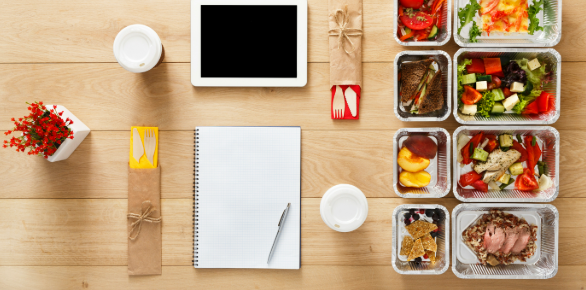Meal Planning Hacks: Cut Costs & Reduce Food Waste
Efficient meal planning is a game-changer for households looking to cut costs and reduce food waste. By creating a healthy meal plan, individuals can save time and money while ensuring they consume nutritious food.

For beginners, starting with a simple plan can make a significant difference. It involves identifying dietary needs, planning grocery shopping, and preparing meals in advance. This approach not only helps in saving time but also in reducing the likelihood of buying unnecessary items, thus cutting down on waste.
Key Takeaways
- Plan your meals around what’s on sale at the grocery store.
- Use up leftovers to reduce food waste.
- Shop from local farmers to get fresh produce.
- Keep a well-organized pantry to avoid duplicate purchases.
- Prepare meals in advance to save time during the week.
The Financial and Environmental Benefits of Meal Planning
By adopting a meal planning routine, individuals can significantly reduce their grocery bills and environmental footprint. Meal planning allows for a more organized approach to grocery shopping, ensuring that only necessary items are purchased and reducing the likelihood of impulse buys.
How Strategic Planning Cuts Your Grocery Bills
Strategic meal planning involves creating a budget-friendly meal prep plan that revolves around seasonal produce and sales. By planning meals around what’s on sale, individuals can significantly cut their grocery bills. Additionally, buying in bulk and using coupons can further reduce costs. A well-planned meal strategy helps avoid last-minute, often expensive, dining out or takeout.
Reducing Your Carbon Footprint Through Less Food Waste
A key aspect of meal planning is reducing food waste, which directly contributes to a lower carbon footprint. By planning meals and making a corresponding grocery list, individuals can avoid buying too much food that may go to waste. Utilizing leftovers and planning meals around what’s already in the pantry are effective strategies for minimizing waste. This approach not only saves money but also reduces the environmental impact of food production and disposal.
Setting Up Your Meal Planning System
A well-structured meal planning system is key to achieving your financial and environmental goals in the kitchen. By understanding your family’s preferences and needs, you can create a plan that is both effective and sustainable.
Evaluating Your Family’s Food Preferences and Needs
Start by assessing your family’s eating habits. Consider dietary restrictions, food allergies, and personal preferences. This step is crucial in creating a meal plan that everyone will enjoy and adhere to.
Establishing Achievable Planning Goals
Set realistic goals for your meal planning. This could include reducing food waste, cutting down on grocery bills, or cooking more meals at home. Having clear objectives will help guide your planning process.
Essential Tools for Successful Meal Planning
The right tools can make meal planning easier and more efficient. You can choose between digital and physical planning methods, depending on what works best for you.
Digital vs. Physical Planning Methods
Digital meal planning apps offer flexibility and accessibility, while physical planners provide a tactile experience. Consider what suits your lifestyle best.
Meal Planning Apps Worth Trying
Some popular meal planning apps include those that offer recipe suggestions, grocery list organization, and nutritional information. Examples include Plan to Eat and Yummly.
| App Name | Features | Platform |
|---|---|---|
| Plan to Eat | Recipe organization, meal planning | Web, iOS |
| Yummly | Recipe suggestions, nutritional info | Web, iOS, Android |
Master Your Food Inventory Management
Mastering your kitchen’s inventory can significantly reduce food waste and save money. By understanding what you have at home, you can plan meals more effectively, avoid duplicate purchases, and ensure that your food is consumed before it expires.
Conducting an Effective Pantry Audit
Begin by taking stock of your pantry staples for meal prep. Remove everything and sort items into categories. Check expiration dates and dispose of any expired or spoiled food. This process helps you understand what you have, what you need, and what you can use in your meal planning.

Organizing Your Refrigerator for Visibility and Freshness
To organize your fridge for meal planning, start by cleaning it thoroughly. Use storage bins and baskets to categorize items, making it easier to see what you have. Store frequently used items at eye level, and keep your fridge at the right temperature to maintain freshness.
Creating a Functional Freezer Inventory System
A well-organized freezer is crucial for meal prep. Use airtight containers or freezer bags to store food, and label them clearly. Implement a system to keep track of what’s inside, such as a whiteboard or a digital note on your phone.
Labeling Systems That Prevent Waste
Using a labeling system can help prevent food waste by ensuring you use older items first. Label containers with the date and contents, making it easy to identify what’s inside.
First In, First Out (FIFO) Method
The FIFO method ensures that older items are consumed before newer ones. By applying this method, you can reduce the risk of expired or spoiled food, making your meal planning more efficient and cost-effective.
Budget-Conscious Meal Planning Strategies
Adopting a budget-conscious approach to meal planning can significantly reduce your grocery bills and food waste. By being mindful of your spending and planning your meals around what’s available and affordable, you can enjoy delicious meals without breaking the bank.
Leveraging Seasonal Produce for Maximum Value
One of the simplest ways to save money on groceries is by incorporating seasonal produce into your meal plans. Produce that’s in season is not only fresher but also cheaper due to lower demand for transportation and storage. Plan your meals around seasonal fruits and vegetables to get the most value out of your grocery budget.
Smart Bulk Buying Practices
Bulk buying can be a cost-effective strategy, but it requires some planning to execute effectively. Buy items that are non-perishable or can be easily stored, such as grains, canned goods, and nuts. Consider the cost per unit to ensure you’re getting a good deal. Here’s a simple comparison:
| Item | Bulk Price | Unit Price |
|---|---|---|
| Rice (20 lbs) | $25 | $1.25/lb |
| Rice (5 lbs) | $10 | $2/lb |
Strategic Use of Sales, Coupons, and Store Rewards
Make the most of your grocery shopping by taking advantage of sales, coupons, and store rewards programs. Plan your meals around items that are on sale, and stock up on non-perishable items when they’re at their cheapest. Digital coupons and store loyalty programs can also offer significant savings. Combine these strategies with your meal planning to maximize your savings.

By implementing these budget-conscious meal planning strategies, you can enjoy significant savings on your grocery bills while reducing food waste. The key is to be flexible, plan ahead, and make the most of the resources available to you.
Efficient Meal Prep Techniques
Mastering meal prep is a game-changer for busy individuals looking to save time and reduce food waste. By adopting efficient meal preparation strategies, you can enjoy healthy meals while minimizing your grocery bills.
Batch Cooking Fundamentals for Busy Weeks
Batch cooking is a cornerstone of efficient meal prep. It involves preparing large quantities of a single ingredient or entire meals that can be consumed over several days. This approach not only saves time during the week but also reduces the stress of deciding what to eat. To get started with batch cooking, identify recipes that freeze well or can be refrigerated for several days. Consider making large batches of grains, proteins, and roasted vegetables that can be mixed and matched throughout the week.
Time-Saving Preparation Hacks
To maximize efficiency, incorporate time-saving hacks into your meal prep routine. One effective strategy is to prep ingredients for multiple meals simultaneously. For example, chopping a large quantity of onions or bell peppers at once can save time during the week. Another hack is to use a slow cooker or Instant Pot to prepare meals that simmer or cook while you’re busy with other tasks.

Food Storage Solutions That Extend Freshness
Proper food storage is crucial for maintaining the freshness and safety of your prepped meals. Investing in the right container systems and understanding proper storage temperatures can make a significant difference.
Container Systems Worth Investing In
Choosing the right containers can help keep your meals fresh. Look for containers that are airtight, microwave-safe, and dishwasher-friendly. Glass containers are a popular choice because they are non-toxic and can be used for both storage and reheating.
Proper Storage Temperatures for Different Foods
Different foods require different storage temperatures to stay fresh. For instance, raw meat and dairy products should be stored at the coldest parts of the refrigerator, typically below 40°F (4°C). Understanding these temperature requirements can help prevent spoilage and foodborne illness.
| Food Type | Storage Temperature | Container Type |
|---|---|---|
| Raw Meat | Below 40°F (4°C) | Airtight Containers |
| Dairy Products | Below 40°F (4°C) | Sealed Containers |
| Prepared Meals | Below 40°F (4°C) or Frozen | Airtight, Microwave-Safe Containers |
Creating Flexible Weekly Meal Plans
Creating a flexible weekly meal plan can help you adapt to changing circumstances while keeping your grocery bills in check. A flexible meal plan allows you to make adjustments as needed, ensuring that you can accommodate changes in your schedule or preferences without wasting food or money.
Template-Based Planning for Simplicity
Using a template can simplify the meal planning process. A weekly meal planner template provides a structured format, making it easier to plan your meals for the week. You can find various templates online or create your own based on your family’s preferences and dietary needs.

Strategic Incorporation of Planned Leftovers
Incorporating planned leftovers into your meal plan can significantly reduce food waste. By designating certain meals as “leftover nights,” you can ensure that you use up all the food you prepare. This approach also saves time during the week when you’re busy.
Building Adaptability Into Your Meal Schedule
To build adaptability into your meal schedule, consider leaving some flexibility in your plan. You can designate one or two nights as “flex nights” where you can choose a meal based on what’s available or your mood. This approach helps you stay on track while allowing for spontaneity.
| Meal Planning Strategy | Benefits | Tips for Implementation |
|---|---|---|
| Template-Based Planning | Simplifies the planning process | Choose a template that fits your family’s needs |
| Planned Leftovers | Reduces food waste and saves time | Designate specific nights for leftovers |
| Flexible Meal Nights | Allows for spontaneity and adaptability | Leave one or two nights open for flexible meal choices |
From Meal Plan to Grocery List: Smart Shopping
A strategic grocery list is the bridge between meal planning and smart shopping. By transforming your meal plan into a well-organized list, you can shop more efficiently, reduce food waste, and stick to your budget.
Organizing Your Shopping List by Store Layout
One effective way to streamline your grocery shopping is to organize your list according to the store’s layout. This approach helps you navigate the aisles more efficiently, ensuring that you don’t miss essential items and reducing the likelihood of impulse buys. By grouping similar items together, such as produce, dairy products, and canned goods, you can make your shopping experience smoother and faster.
Digital Tools That Streamline Grocery Shopping
In today’s digital age, numerous apps and tools can help you manage your grocery list more effectively. Apps like AnyList and Out of Milk allow you to create, organize, and share your grocery list with family members. These digital tools often include features such as coupon clipping, sales alerts, and store loyalty programs, making it easier to stick to your budget and plan your shopping trips.
Avoiding Impulse Purchases That Break Your Budget
Impulse buys can quickly derail your budget and disrupt your meal planning efforts. To avoid this, it’s essential to stick to your list and resist the temptation of sales or promotions that aren’t on your plan. By having a clear plan and a well-organized list, you can minimize the risk of impulse purchases and stay focused on your shopping goals.
Specialized Meal Planning for Different Dietary Needs
Whether you’re vegetarian, vegan, gluten-free, or cooking for picky eaters, effective meal planning is key to satisfying everyone’s tastes. Different dietary requirements don’t have to complicate your meal planning routine; with the right strategies, you can cater to everyone’s needs.
Vegetarian and Vegan Planning Approaches
For vegetarians and vegans, meal planning involves ensuring adequate protein and nutrient intake. Plant-based proteins like beans, lentils, and tofu are staples. Incorporating a variety of colorful vegetables ensures a broad spectrum of vitamins and minerals.
A sample vegan meal plan might include:
- Breakfast: Oatmeal with almond milk and fruit
- Lunch: Quinoa salad with roasted vegetables
- Dinner: Lentil soup with whole grain bread
Gluten-Free and Allergen-Friendly Meal Plans
Gluten-free meal planning requires careful attention to ingredient labels. Naturally gluten-free foods like fruits, vegetables, and lean proteins are safe choices. For those with other food allergies, identifying and avoiding allergens is crucial.
| Dietary Need | Safe Foods | Foods to Avoid |
|---|---|---|
| Gluten-Free | Fruits, Vegetables, Lean Proteins | Wheat, Barley, Rye |
| Vegan | Plant-Based Proteins, Grains | Animal Products |
Family-Friendly Planning That Satisfies Picky Eaters
Meal planning for families with picky eaters involves incorporating familiar foods while introducing new dishes gradually. Involving children in meal planning can increase their willingness to try new foods.
Creating Kid-Approved Meals That Adults Enjoy Too
Meals like pasta with marinara sauce or tacos can be adapted to suit both children and adults. Using kid-friendly ingredients in creative ways can make mealtime more enjoyable for everyone.
Balancing Nutrition and Preferences
It’s essential to strike a balance between nutritional value and personal preferences. Offering a variety of healthy options and allowing family members to have input can help achieve this balance.
By adopting these specialized meal planning strategies, you can ensure that your meals are both healthy and enjoyable for everyone, regardless of their dietary needs.
Creative Ways to Repurpose Ingredients and Reduce Waste
The art of reducing food waste lies in creatively repurposing ingredients that would otherwise end up in the trash. By adopting a few simple strategies, you can significantly cut down on waste and make your meal planning more efficient.
Transforming Leftovers Into Entirely New Meals
Leftovers can be a treasure trove for creative meal planning. Consider turning last night’s roast chicken into tomorrow’s chicken salad or using leftover vegetables to make a hearty soup. Here are some ideas:
- Use leftover meats in soups, stews, or casseroles.
- Transform leftover vegetables into frittatas or stir-fries.
- Make croutons from stale bread for salads.
Using Vegetable Scraps, Peels, and Stems
Many vegetable scraps can be repurposed into nutritious meals or stocks. For example, you can use:
- Carrot tops and celery leaves to make a flavorful pesto.
- Onion peels and vegetable scraps to create a rich broth.
- Potato peels to make crispy potato skin snacks.
Freezing Techniques to Extend Food Lifespan
Freezing is an excellent way to extend the lifespan of perishable ingredients. Consider:
- Freezing herbs in olive oil or ice cube trays.
- Blanching and freezing vegetables like broccoli and green beans.
- Freezing leftover soups or stews for future meals.
By incorporating these strategies into your meal planning routine, you can significantly reduce food waste and make your cooking more sustainable and cost-effective.
Conclusion: Sustainable Habits for Long-Term Meal Planning Success
Developing sustainable meal planning habits is crucial for achieving long-term success. By implementing the strategies outlined in this article, individuals can cultivate healthy habits that promote meal planning for weight loss and overall well-being.
Sustainable meal planning involves creating a balanced and flexible approach to meal preparation. This can be achieved by leveraging seasonal produce, using smart bulk buying practices, and repurposing ingredients to reduce waste. By adopting these habits, individuals can enjoy the benefits of meal planning, including reduced grocery bills and a lower carbon footprint.
To maintain long-term meal planning success, it’s essential to stay committed to healthy habits and continue refining meal planning tips and techniques. By doing so, individuals can ensure that meal planning becomes a sustainable and enjoyable part of their lifestyle, leading to a healthier and more sustainable relationship with food.
FAQ
What are the benefits of meal planning?
Meal planning offers numerous benefits, including saving time, reducing food waste, cutting costs, and promoting healthy eating. It also helps in managing dietary needs and preferences, whether it’s for a family or an individual.
How do I start meal planning for my family?
To start meal planning, begin by evaluating your family’s food preferences and dietary needs. Then, set achievable planning goals and choose a meal planning method that works for you, whether digital or physical.
What are some effective meal planning strategies for reducing food waste?
Strategies for reducing food waste include planning meals around seasonal produce, using up leftovers, and conducting regular pantry audits. Implementing a “first in, first out” inventory system also helps.
How can I save money through meal planning?
Saving money through meal planning can be achieved by leveraging seasonal produce, practicing smart bulk buying, and making strategic use of sales, coupons, and store rewards. Planning meals around what’s on sale can significantly cut grocery bills.
What are some tips for meal planning on a budget?
Budget-friendly meal planning involves planning meals around affordable ingredients, buying in bulk, and avoiding last-minute, often expensive, dining decisions. Using cashback apps and store loyalty programs can also help.
How can I meal plan for special dietary needs?
For special dietary needs, such as vegetarian, vegan, or gluten-free, focus on planning meals that cater to those requirements. Research recipes that fit the dietary needs and make a grocery list accordingly.
What are some efficient meal prep techniques?
Efficient meal prep techniques include batch cooking, preparing ingredients in advance, and using a slow cooker. Proper food storage solutions, like airtight containers, also help in keeping meals fresh.
How can I create a flexible weekly meal plan?
Creating a flexible meal plan involves using a template, incorporating planned leftovers, and being open to adjusting the plan as needed. This flexibility helps in accommodating last-minute changes or unexpected events.
What are some digital tools that can aid in meal planning and grocery shopping?
Several meal planning apps, such as Plan to Eat, Yummly, and Mealime, can help organize meal plans and generate grocery lists. Digital tools like these streamline the meal planning process and make grocery shopping more efficient.
How can I avoid impulse purchases while grocery shopping?
To avoid impulse buys, stick to your grocery list, shop the perimeter of the store first, and avoid shopping when you’re hungry. Using cash instead of credit cards can also help in sticking to your budget.







